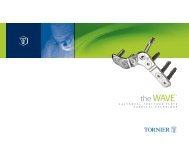Stabilis™ Surgical Technique (PDF) - Tornier DX
Stabilis™ Surgical Technique (PDF) - Tornier DX
Stabilis™ Surgical Technique (PDF) - Tornier DX
You also want an ePaper? Increase the reach of your titles
YUMPU automatically turns print PDFs into web optimized ePapers that Google loves.
8<br />
T O r N i E r ® S t a b i l i S a n k l e a r t h r o d e S i S P l a t i n g S y S t e m<br />
Step 16<br />
Remove all cross-joint pins. Insert one end of the Compressor<br />
in the proximal hole of the Tibia Hole Guide as shown. Push it<br />
down fully to the bottom of the hole. Position the other distal<br />
end of the Compressor on the tibia, above the proximal end<br />
of the plate, leaving sufficient room so not to interfere with<br />
the plate when compression is applied. Typically a 10 mm gap<br />
or more is adequate between the proximal end of the plate<br />
and the Compressor. Position the proximal Compressor collet<br />
longitudinally in line with the plate. Insert a 2.5 x 100 mm Pin<br />
through the collet on this compressor end and drive it into the<br />
tibia bicortically. Turn the knob to tighten the collet against<br />
the pin. Keep the Compressor fully seated in the hole of the<br />
Tibial Hole Guide during this step, and avoid rotating the<br />
Compressor handles towards the proximal pin. If necessary,<br />
loosen the knob and realign the Compressor and tighten the<br />
knob again. Squeeze the Compressor handles. Tighten the<br />
thumb screw on the back of the Compressor to lock the<br />
ratchet in place.<br />
2.5 x 100 mm Pins Joint Compressor<br />
<strong>Surgical</strong> Note:<br />
Keeping the Compressor straight will typically result in a small<br />
gap between the tibial cortex and the proximal Compressor<br />
end on the pin. This is acceptable.<br />
Take care to compress the joint evenly. Avoid rotating the tibia<br />
during compression and creating a gap in the posterior joint<br />
space. Verify reduction under AP and lateral fluoroscopy. If<br />
necessary, release the compression, remove the Compressor,<br />
plantarflex the ankle and use the Plate Benders to bend the<br />
plate at the two bending zones for a better fit or even compression.<br />
Step 17<br />
Insert the Drill Guide into each of the proximal screw holes.<br />
Seat the guide squarely on the shoulder in the hole. Drill the<br />
proximal plate screw hole. Use the Depth Gauge to measure<br />
the hole’s depth. Select the appropriate screw length and<br />
place the screw. Repeat the process for the other screw hole.<br />
Drill Guide 2.7 mm Drill Bit<br />
Depth Gauge Bone Screw<br />
Ratcheting AO<br />
Driver Handle<br />
Star Screw Driver<br />
Alternatively, two Compressors may be used to compress the<br />
joint. Position one on either side of the plate, across the joint, at<br />
approximately 70° from each other – like the Distractors were<br />
positioned in Step 2. Use 2.5 x 100 mm Pins to secure one end<br />
of each Compressor into the tibia and other end in the talus.<br />
Tighten the collets against the pins. Squeeze both handles to<br />
compress the joint.




